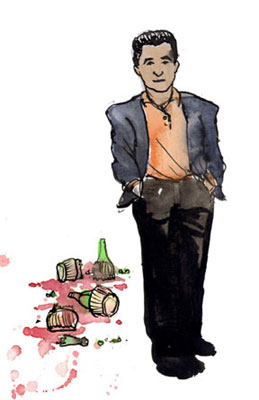
 Sangiovese
Sangiovese
You’re a modest boy from Tuscany, seeking fame and fortune. You shed your woven straw attire for more austere threads of tannin with silky orange accents. At home, you began to turn your back on the rough childhood companions from the neighborhood, preferring to hang out in the cafes of Chianti with the French nobleman, King Cabernet. Now in America you’re the most stylish of a new generation of Italian immigrants. It appears that unassuming little boy named after the ‘Blood of Jupiter’ always was a would-be king himself… Italian royalty.
Appellations Growing Sangiovese Grapes
Appellations producing the most Sangiovese wines:
Sangiovese Grape Details
 Sangiovese (aka. Sangioveto, Prugnolo, Brunello)
Sangiovese (aka. Sangioveto, Prugnolo, Brunello)
Sangiovese has proved successful in a wide range of California’s viticultural areas, producing medium-bodied wines with classic prune, cherry character aromatics and pleasant acidity. The variety was originally brought to California by pioneering Italian immigrants. It is surprising, however, that in an industry dominated by such names as Mondavi, Gallo, Trinchero, Martini, and Sebastiani, it wasn’t until the 1990s that this most illustrious of Italian grapes finally began to be planted with significant acreage in California.
The name originates from sanguis Jovis, or “blood of Jupiter". From this, one would expect a potent wine. However, in Italy’s Tuscany region, Sangiovese’s performance can be remarkably erratic -- reaching great heights of quality, in addition to tremendous disappointments. The variety is responsible for both the thin, insipid, ascetic wines of the most basic of Chiantis; and also the highly-concentrated reds of Brunello di Montalcino, Vino Nobile di Montepulciano and Morellino di Scansano. The reason lies in the fact that Sangiovese is perhaps the best example of how within a single variety many clones of varying capabilities can exist. Investigating the many clones can be dizzying and difficult, as most wines made from Sangiovese in Tuscany are blended with everything from the prestigious red grape Cabernet Sauvignon, to one of the least noble white varietals, Trebbiano. All that said, there are indeed common links in character across clonal variation. Sangiovese tends to be rather lightly-pigmented (the Brunello clone being a notable exception) and the wines -- even younger examples -- often cast a slight orange tinge at their margin in the glass. This characteristic can be a sly clue to experienced brown-baggers in blind tastings. Pronounced acidity is also an important common characteristic across clonal variation and even the most structured of Sangiovese wines have a firm acidic backbone. Other common descriptors for the aromatics of the variety often include prunes, dark cherry and earthy barnyard.







